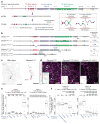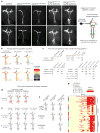Robust discrimination between self and non-self neurites requires thousands of Dscam1 isoforms
- PMID: 19794492
- PMCID: PMC2836808
- DOI: 10.1038/nature08431
Robust discrimination between self and non-self neurites requires thousands of Dscam1 isoforms
Abstract
Down Syndrome cell adhesion molecule (Dscam) genes encode neuronal cell recognition proteins of the immunoglobulin superfamily. In Drosophila, Dscam1 generates 19,008 different ectodomains by alternative splicing of three exon clusters, each encoding half or a complete variable immunoglobulin domain. Identical isoforms bind to each other, but rarely to isoforms differing at any one of the variable immunoglobulin domains. Binding between isoforms on opposing membranes promotes repulsion. Isoform diversity provides the molecular basis for neurite self-avoidance. Self-avoidance refers to the tendency of branches from the same neuron (self-branches) to selectively avoid one another. To ensure that repulsion is restricted to self-branches, different neurons express different sets of isoforms in a biased stochastic fashion. Genetic studies demonstrated that Dscam1 diversity has a profound role in wiring the fly brain. Here we show how many isoforms are required to provide an identification system that prevents non-self branches from inappropriately recognizing each other. Using homologous recombination, we generated mutant animals encoding 12, 24, 576 and 1,152 potential isoforms. Mutant animals with deletions encoding 4,752 and 14,256 isoforms were also analysed. Branching phenotypes were assessed in three classes of neurons. Branching patterns improved as the potential number of isoforms increased, and this was independent of the identity of the isoforms. Although branching defects in animals with 1,152 potential isoforms remained substantial, animals with 4,752 isoforms were indistinguishable from wild-type controls. Mathematical modelling studies were consistent with the experimental results that thousands of isoforms are necessary to ensure acquisition of unique Dscam1 identities in many neurons. We conclude that thousands of isoforms are essential to provide neurons with a robust discrimination mechanism to distinguish between self and non-self during self-avoidance.
Figures




Similar articles
-
Intron-targeted mutagenesis reveals roles for Dscam1 RNA pairing architecture-driven splicing bias in neuronal wiring.Cell Rep. 2021 Jul 13;36(2):109373. doi: 10.1016/j.celrep.2021.109373. Cell Rep. 2021. PMID: 34260933
-
Self-avoidance alone does not explain the function of Dscam1 in mushroom body axonal wiring.Curr Biol. 2022 Jul 11;32(13):2908-2920.e4. doi: 10.1016/j.cub.2022.05.030. Epub 2022 Jun 2. Curr Biol. 2022. PMID: 35659864
-
Dscam diversity is essential for neuronal wiring and self-recognition.Nature. 2007 Sep 13;449(7159):223-7. doi: 10.1038/nature06099. Nature. 2007. PMID: 17851526 Free PMC article.
-
The molecular basis of self-avoidance.Annu Rev Neurosci. 2013 Jul 8;36:547-68. doi: 10.1146/annurev-neuro-062111-150414. Annu Rev Neurosci. 2013. PMID: 23841842 Review.
-
Molecular diversity of Dscam and self-recognition.Adv Exp Med Biol. 2012;739:262-75. doi: 10.1007/978-1-4614-1704-0_17. Adv Exp Med Biol. 2012. PMID: 22399408 Review.
Cited by
-
Characterization of a Single Genomic Locus Encoding the Clustered Protocadherin Receptor Diversity in Xenopus tropicalis.G3 (Bethesda). 2016 Aug 9;6(8):2309-18. doi: 10.1534/g3.116.027995. G3 (Bethesda). 2016. PMID: 27261006 Free PMC article.
-
Regulation of Dscam exon 17 alternative splicing by steric hindrance in combination with RNA secondary structures.RNA Biol. 2013 Dec;10(12):1822-33. doi: 10.4161/rna.27176. Epub 2013 Nov 21. RNA Biol. 2013. PMID: 24448213 Free PMC article.
-
Splicing heterogeneity: separating signal from noise.Genome Biol. 2018 Jul 9;19(1):86. doi: 10.1186/s13059-018-1467-4. Genome Biol. 2018. PMID: 29986741 Free PMC article.
-
Molecular logic of neuronal self-recognition through protocadherin domain interactions.Cell. 2015 Oct 22;163(3):629-42. doi: 10.1016/j.cell.2015.09.026. Epub 2015 Oct 17. Cell. 2015. PMID: 26478182 Free PMC article.
-
A systematic CRISPR screen reveals redundant and specific roles for Dscam1 isoform diversity in neuronal wiring.PLoS Biol. 2023 Jul 6;21(7):e3002197. doi: 10.1371/journal.pbio.3002197. eCollection 2023 Jul. PLoS Biol. 2023. PMID: 37410725 Free PMC article.
References
Publication types
MeSH terms
Substances
Grants and funding
LinkOut - more resources
Full Text Sources
Molecular Biology Databases

